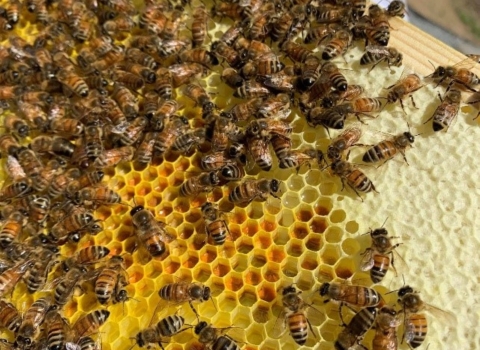Do you love California pollinators? Have you dreamed about redesigning your yard to incorporate California native plants to help pollinators, but worry that it will turn out looking out of control or brown? Stephen Curry, a botanist and biologist in the Sacramento Fish and Wildlife Office, says that doesn’t have to be the case.
“I have heard concerns that landscaping with California native plants can make a garden look unruly, but most native plants look formal or can be maintained like traditional landscaping, all while using little water and helping pollinators.”
As we step into the hot summer months, we asked Stephen about landscaping with California native plants and how to get a great looking yard.
USFWS: What are some benefits of landscaping with California native plants?
Stephen: California native plants are adapted to our climate. Most are used to long periods of drought, too. Gardening with California native plants can reduce water use and provide local pollinators habitat year-round. Once your garden is established, you only need to water once or twice a month (and maybe not at all) to keep the plants looking their best.
USFWS: When should people transition their yards to California native plant landscaping?
Stephen: February through the end of summer is the time to start planning your native landscaping conversion project. Many water districts offer rebates specifically to help cover the cost of high-water use to native landscape conversion projects, so check with them first. During this period, research plants, consider your soil type/s, determine project layout, and purchase efficient irrigation equipment. This is when you should let your lawn die, as well as do any digging, hardscaping or soil replacement.
USFWS: When should you put native plants in the ground?
Stephen: From mid-September to November, you can purchase the plants for your yard. Many nurseries have big sales that time of year, too.
Start planting in the ground near the end of October. At that point, the ground is still warm, and many plants are in their active growth phase. You will only need to irrigate a few times before the rainy season hits, which provides the plants with all the moisture they need to settle into their new home.
USFWS: What should people think about as they’re planning their native plant landscape?
Stephen: There are a few things people should keep in mind as they’re designing their native plant landscape.
First, sunlight. Before you plant, identify which parts of your yard are full-sun, morning-sun, part-sun, and full-shade. Some native plants will roast in full sun, while others need hot sun for several hours to thrive.
Second, if you’re trying to achieve a “formal” look, replicate traditional garden designs. For instance, lots of native plants can be trimmed into hedges and shaped to fit your yard, like coffeeberry. Additionally, I like to use different “elevations” so you are drawn throughout the yard to see each plant. You should grow taller shrubs in the back and cascading groundcovers spilling over ledges and around rocks in the front.
Third, consider near-term and long-term watering needs. Most native plants will need more frequent irrigation during their first summer. Some native plants need more water than others. Many native plants are not drought tolerant at all, while some – such as the flannelbushes – may die if you directly water them in the summer after establishment.
Finally, to help native pollinators, use both food plants and host plants. For food plants, consider different species that flower throughout the year. Generally, California fuchsias bloom in fall, manzanitas in winter, ceanothus and sages in spring, and buckwheats in summer. By thinking about this, you have an opportunity to attract and support bees, butterflies, and birds year-round.
USFWS: What are some of your favorite plants?
Stephen: For shady areas, I love hummingbird sage. They do best in coastal areas and on the north or east side of buildings, or under an established tree. The plant has hot-pink flowers and smells like fruit punch. In fact, you can make tea out of it! Other great plants for shady areas are native alumroots and irises. They’re all drought tolerant with pretty flowers which pollinators love.
For areas with full sun, I like our native buckwheats. Some are groundcovers, while others are massive shrubs. Buckwheats can be called pioneer species because they will grow in the most inhospitable of conditions. Bees and hummingbirds love our native manzanitas and sages, which also grow well in the hot sun.
USFWS: How do I take care of native plants?
Stephen: Native plants are relatively easy to maintain. Once established, only watering a few times during the summer can be sufficient. I recommend using in-line drip emitter tubing for peak water efficiency. Yards with native plants also need less maintenance. Generally, you only need to trim once a year in the fall, just before the rains start. But be careful, some plants should seldom be overly cut, like manzanitas or bush poppies. So, make sure you talk to the staff at a native plant nursery or read online about the specific dos and don’ts for each plant species.










